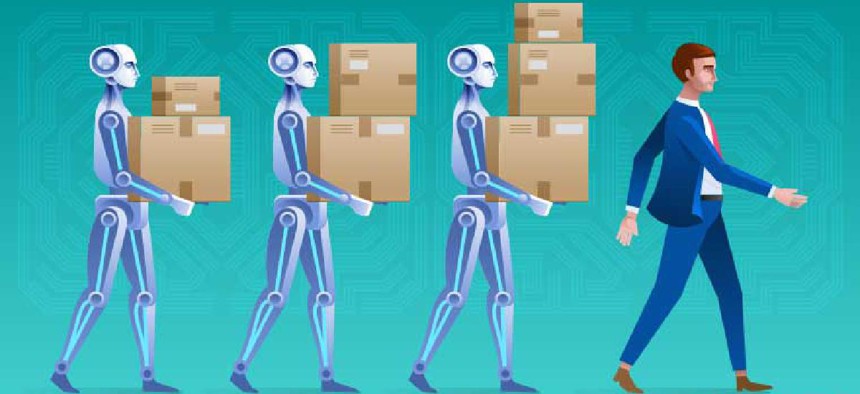Co-robots: Next-gen collaboration technology?

The National Robotics Initiative 2.0 is focusing even more on seamlessly integrating robots to assist humans in every aspect of life.
Robots: They could take all of our jobs, help us by enriching human experiences or just get really good at dancing.
The National Science Foundation and other federal agencies have been devoting millions of dollars to robotics research for years. Launched in 2011, the National Robotics Initiative funded dozens of robotics projects in labs across the country and lasted about five years. It was deemed so successful that NSF decided to relaunch it as NRI 2.0.
“From the beginning, the National Robotics Initiative has emphasized co-robots -- so that’s robots working in partnership with people to perform tasks,” said Joydip Kundu, deputy director of NSF’s Directorate for Computer and Information Science and Engineering Division of Information and Intelligent Systems.
NRI 2.0 is focusing even more on how teams of humans can work together with teams of robots, he said. NASA, for example, is interested in robots that can aid in human space exploration, while the Department of Energy is more focused on robots that could assist in remediation of radioactive sites or traversing dangerous areas.
“Imagining a future where robots might be as ubiquitous as computers and cellphones are today,” Kundu said. “What would it take to realize that? How could we do that in a way that provides a positive benefit to people?”
So what has been the result of robotics funding over the good part of the last decade? Here’s a look at five NRI-funded robotics projects.
On the frontlines of an epidemic
Between 2014 and 2016, Ebola was ravaging the West African countries of Guinea, Liberia and Sierra Leone, infecting thousands. Guinea experienced a 67 percent death rate associated with the disease, and health workers were far from safe from the outbreak’s deadly effects.
The Centers for Disease Control and Prevention said health care workers caring for Ebola patients “were among those at highest risk for contracting the disease.” An analysis by the World Health Organization found there were 815 confirmed and probable health worker Ebola cases during the outbreak. Of the 635 workers where the final outcome is known, 418 passed away as a result of the disease.
This is why, in 2014, researchers at the University of Michigan and Worcester Polytechnic Institute in Massachusetts began testing a robot that would assist medial workers in the process of removing masks and protective suits that had come in close contact with patients.
The robot, using two mechanical arms, is able to pull a protective hood over an individual’s head and help pull off coveralls.
Watch: A robot to help medical workers disrobe.
Helping the visually impaired
Researchers at Carnegie Mellon University has been working to understand how blind and visually impaired people might interact with robots in hopes in better understanding how these machines could help blind travelers safely navigate unfamiliar environments.
At the University of Arkansas at Little Rock, researchers have developed a co-robotic cane that uses a 3D camera to help the visually impaired detect indoor structures, such as stairways and doorways, and objects, such as tables and computer monitors. It can also guide the user by detecting human intent and steering into the desired travel direction.
An “autonomous airborne scientist”
A warning a few minutes ahead of a tornado can allow individuals to get to shelter. There are a number of ways to improve a prediction model, but one method is to use more data from autonomous drones. Researchers at the University of Colorado Boulder suggested a drone -- combined with cloud computing, a mesh communication network, weather models and sensors – could be an “autonomous airborne scientist” that could collect better weather data in an effort to improve the lead-time of tornado warnings.
A modular machine for many options
One of the frustrating aspects of today’s robots is they’re not very versatile. They’re good a vacuuming the floor or assisting in the manufacturing of a car, but those two robots wouldn’t be able to trade jobs.
Researchers at Cornell University are working on creating more modular robots along with a library of possible behaviors, which could be one step toward a more general robot partner
The goal is to give a robot a task, without explicitly programing all the required steps of the assigned job, according to Hadas Kress-Gazit, an associate professor in the Cornell Sibley School of Mechanical and Aerospace Engineering and principal investigator on the project.
The robot is made of modular components -- small squares with wheels on them -- that the machine can reconfigure depending on the specific job it is trying to accomplish.“We are creating a modular system that is able to do different tasks autonomously,” Kress-Gazit said in a statement. “By changing the high-level task, it totally changes its behavior.”
Watch: A modular robot for a variety of tasks.
Editor's note: This aritcle was changed Dec. 5 to clarify Joydip Kundu's title.





